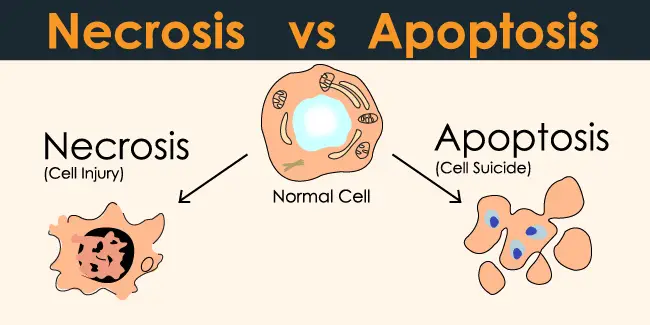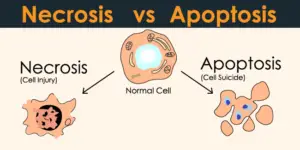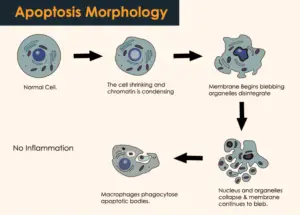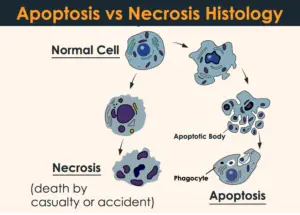
Apoptosis vs necrosis, These Two Different Cell Death Types Will Amaze You.
The basic difference is that apoptosis is a natural process, it genetically programs and responds to homeostatic mechanisms. It is a kind of physiological and active “conscious suicide” of cells. While necrosis, it is an acute process produce by massive cell injury. It is the type of cell death caused by trauma.

The death of cells in human tissues and in other multicellular organisms is a normal event and does not cause alteration of functions. Cell death is the cessation of a cell’s vital functions produce by irreversible morphological, functional, and chemical changes.
It can occur due to many and various causes: loss of function, mechanical damage, infections, chemical agents, or lack of nutrients, among others.
What are types of cell death?
There are two types of cell death modes.
- Apoptosis
- Necrosis
Let’s dig into more detail.
Apoptosis vs Necrosis Differences side by side:
| Apoptosis | Necrosis |
| 1. Apoptosis is “programmed” cell death. | Necrosis is “premature” cell death. |
| 2. Its process is triggered by physiological or pathological conditions without loss of ATP levels because it requires energy to carry it out. | Its process is triggered by toxins, severe hypoxia, massive aggression, and any other condition that causes ATP drop. |
| 3. During necrosis, the DNA breaks into random irregular fragments. | Chromatin does not break but condenses into apoptotic bodies. |
| 4. It affects an extensive group of cells | It affects only isolated cells. |
| 5. It is a natural physiological process. | While it is a pathological process that is caused by external agents such as toxins, injuries, and infections. |
| 6. Histologically it characterizes by the condensation or shrinkage of the cell organelles found in the cytoplasm. | In necrosis, organelles decay as a result of edema. Organelles in a necrotic cell do not function after cell death. |
| 7. Plasma membrane bleeding observes without loss of integrity. | The integrity of the membrane impair. |
| 8. The biggest feature of this death mode is that it can limit inflammation Overreaction occur. | It can cause a significant inflammatory response. |
| 9. It is a caspase-dependent pathway. | It is a caspase-independent pathway. |
| 10. The formation of apoptotic bodies with their subsequent phagocytosis or secondary necrosis | Cell destruction and disintegration |
| 11. Neither inflammation nor tissue damage caused by apoptosis. | A significant inflammatory reaction produced by the body’s immune system with necrosis. It can cause tissue damage. |
is cell death a natural phenomenon? Yes, cell death is a natural phenomenon. it might be followed by the natural procedure in which the cell gets dead and being backed up by new one. Or it can be followed by some external factors such as injury, disease, or the organism death.
Watch the video related to Apoptosis vs Necrosis:
What is Apoptosis?
Apoptosis a programmed cell death, which is a regular and control mechanism of growth and development of the body. It regulates death of damage cells, such as viruses, as a result of which the cell breaks up into small particles, which are then absorb by white blood cells. This is also called cell suicide.
It occurs through clearly defined, consistent morphological changes. It involves a family of proteases known as caspases.
Examples of Apoptosis:
There can be a lot of examples of apoptosis but some of them are as below:
- Tadpole to from transformation.
- Embryonic mouse feet development.
- Human nervous system development.
- Embryonic feet & hand development in humans.
Name all morphological stages of apoptosis:
- Cell shrinkage.
- Cell fragmentation.
- Cytoskeleton collapse.
- Nuclear Envelope Disintegrates.
- Excretion of apoptotic bodies from the cell.

What is Necrosis?
Necrosis is another type of cell death that occurs in cells due to their high susceptibility to extreme conditions that differ from normal conditions. It unregulated the death of cells and tissues, under the influence of damaging factors, such as the death of skin cells as a result of burns or frostbite.
It can occur, for example, in some of these situations:
- The center of an infarcted tissue.
- In an area of ischemia -without enough blood
- In the area of a toxin injury
Types of Necrosis:
Types of Necrosis can be of six types as follow:
- Fat Necrosis.
- Fibroid Necrosis.
- Coagulative Necrosis.
- Caseous Necrosis.
- Liquefactive Necrosis.
- Gangrenous Necrosis.
Similarities Between Necrosis and Apoptosis:
Like differences, there are also similarities between apoptosis and necrosis but that are very little to no. The primary similarities between apoptosis and necrosis is that both are mechanisms of cell death, only one is programmed and the other is not. It occurs in normal and pathological conditions.
Apoptosis vs Necrosis Inflammation
A question might trigger in our mind whenever we hear about apoptosis vs necrosis inflammation that if these both are cell death types then they must trigger inflammation, but the answer is not both show inflammation.
The apoptosis cell death do not shows inflammation verses the necrosis type of cell death shows inflammation.
Necrosis triggers inflammation in such a way that cell components of the necrotic cell that are already under inflammation when come into contact with nearby healthy cell clusters, cause more inflammation.
Necrosis is the phenomena that is familiarized with the inflammation caused as the cell in the situation releases intracellular materials known as DAMPs (damage associated molecular pattern) which are the primary key to sterile inflammation pathogenesis that include Alzheimer’s disease, atherosclerosis, ischemia-reperfusion and gout. For instance, the DAMP molecule HMGB1 can be excreted from necrotic cells, and in return stimulates cells around throughout the receptor for advanced glycation end-products to indicates chemokines, adhesion molecules, and proinflammatory cytokines.
Recent studies also demonstrated the presence of multiple passages of the regulated necrosis.
The only classic assumption for apoptosis that apoptotic cells does not trigger inflammation because the apoptotic or the dying cell content retains inside the cell.
Apoptosis vs Necrosis Histology

What is the difference between apoptosis and pyroptosis? Apoptosis as described is a cell death that is caspase mediated with an anti-inflammatory outcome and specific morphological characteristics. Pyroptosis on the other hand is a cell death pathway that ultimately triggers follow inflammation.
Conclusion:
We have gone through a basic overview of apoptosis vs necrosis. Both these are death types of cells. Necrosis can happen as a result of any external injury or a disease that has the ability to trigger inflammation. While apoptosis is a different cell death type from necrosis as it is a programmed/scheduled cell death that can beneficial or harmful in some cases (mostly beneficial as it saves the organism from serious complications.)
You may also enjoy reading: